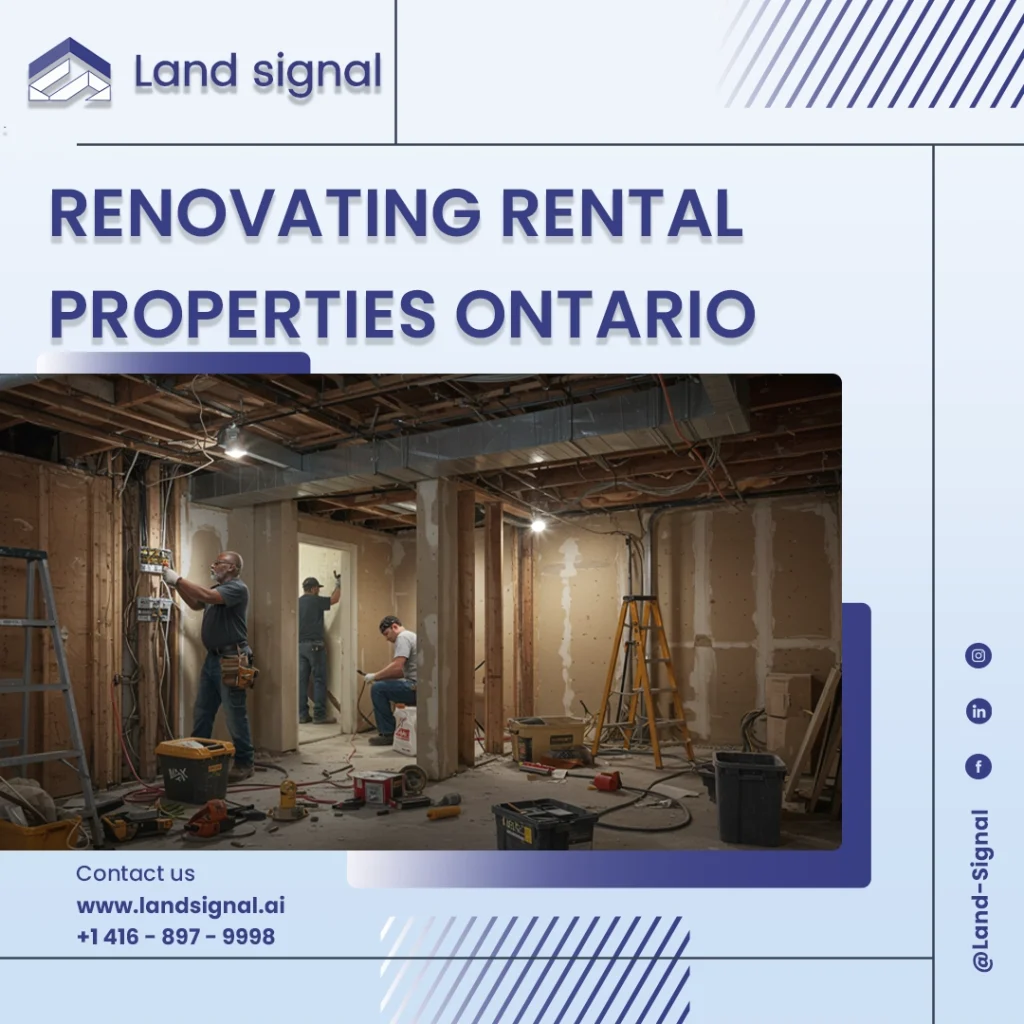In Ontario’s dynamic real estate market, upgrading a rental unit is a pivotal move for any landlord. It’s a dual-sided undertaking that aims to enhance asset value while navigating a dense thicket of provincial and municipal regulations. Success hinges not on ambition alone, but on a disciplined approach that integrates legal compliance, strategic financial planning, and a deep respect for tenant rights.
This guide provides a technical, actionable framework for property owners, moving beyond surface-level advice to deliver insights that can protect and maximize your investment from conception to completion.
Start Your Project with Confidence
At Land Signal, we assist with construction and renovation permits, as well as Garden House and Laneway Suite designs. Let our experts guide you through every step.
Ontario’s Regulatory Landscape
At the heart of any project involving Renovating Rental Properties Ontario lies a critical legal framework governed by the Residential Tenancies Act (RTA) and overseen by the Landlord and Tenant Board (LTB).
These regulations are not mere suggestions; they are mandates that dictate how, when, and under what conditions you can proceed. Missteps can lead to costly disputes and project delays. To navigate this landscape effectively, it’s crucial to understand a few core principles that form the foundation of landlord responsibilities.
- Standard Entry for Repairs: For minor repairs or general maintenance that do not require the unit to be vacant, a landlord must provide the tenant with a minimum of 24 hours’ written notice. This notice must clearly state the reason for entry and specify the date and time.
- Substantial Renovations: When a project is extensive enough to require a municipal building permit and for the tenant to vacate the property, the process becomes significantly more complex. A simple notice is insufficient.
- The Landlord and Tenant Board (LTB): This tribunal holds the authority to adjudicate disputes between landlords and tenants. Any action you take related to renovations can be reviewed by the LTB, making adherence to the RTA paramount.
Upholding Tenant Accommodations
When a renovation is so extensive that it necessitates a vacant unit, the landlord’s obligations extend far beyond simple notification. The process is rigorously structured to protect the tenant’s rights. Successfully managing this phase requires a deep understanding of the tenant’s specific entitlements, which primarily include the following:
N13 Notice Requirements
This is the formal document (Notice to End your Tenancy Because the Landlord Wants to Demolish the Rental Unit, Repair it or Convert it to Another Use) that must be served to the tenant.
- It requires a minimum of 120 days’ notice before the tenancy termination date.
- This form is mandatory for any renovation that requires the unit to be vacant.
Tenant’s Right of First Refusal
The tenant has the legal right to re-occupy the unit once the renovations are complete.
- To exercise this right, the tenant must inform the landlord in writing before they vacate the property.
- The rental rate upon their return must be the same as what they were paying before the renovation.
Mandatory Compensation
Landlords are legally required to compensate the tenant for the displacement.
- Compensation is equivalent to three months’ rent if the property contains five or more residential units.
- For properties with fewer than five units, the compensation is one month’s rent. Alternatively, the landlord can offer the tenant another acceptable rental unit.
High-ROI Renovation Strategies
With a firm grasp of the legal obligations, the focus can shift to the investment itself. For investors Renovating Rental Properties Ontario, the goal is to enhance appeal and maximize rental income without overcapitalizing.
Smart, targeted upgrades will always yield a better return than expensive, unnecessary changes. For landlords, the key is to pinpoint upgrades that offer the most significant return on investment. Below, we’ve outlined the most impactful areas to focus on:
| Renovation Type | Impact on Rental Value | Typical Cost-Effectiveness |
| Kitchen Modernization | High | Update countertops, paint cabinets, and install a new backsplash. |
| Bathroom Refresh | High | Replace the vanity, re-glaze the tub, and update fixtures and lighting. |
| Durable Flooring | Medium-High | Install high-quality laminate or luxury vinyl plank for durability and appeal. |
| Neutral Paint Palette | Medium | A fresh coat of neutral paint is one of the cheapest ways to make a unit feel clean and new. |
| Curb Appeal | Medium | Improve landscaping, paint the front door, and ensure exterior lighting is functional. |
Prudential Project Budgeting
A successful renovation is built on a foundation of meticulous financial planning. Without a realistic budget, projects can easily derail, leading to compromises in quality or incomplete work.
The process of prudently budgeting for Renovating Rental Properties Ontario demands more than just estimating material costs; it involves strategic foresight and disciplined management. A sound financial plan is the backbone of any renovation. To build one, consider these essential components:
- Comprehensive Cost Estimation: Account for everything—materials, labour, permit fees, and disposal costs. Get multiple quotes from contractors.
- Contingency Fund: Always allocate an additional 15-20% of your total estimated budget for unexpected issues. Hidden water damage, outdated wiring, or structural problems are common discoveries.
- Strategic Material Selection: Weigh the upfront cost of materials against their long-term durability and appeal. For a rental, durable and low-maintenance options like quartz countertops or vinyl flooring often provide a better long-term value than more delicate, high-end finishes.
- Professional Labour: While DIY can save money on minor tasks, specialized work (electrical, plumbing, structural) should be left to licensed professionals to ensure compliance with building codes and to avoid future liability.
Read Also: Renovation Cost Calculator Toronto
The Permit Navigation Mandate
Beyond tenant management and budgeting lies the crucial and often complex world of municipal regulations. Any significant structural, electrical, or plumbing work requires a building permit.
Attempting to bypass this stage is a critical error that can result in work-stoppage orders, fines, or the costly need to undo completed work. The process of Renovating Rental Properties Ontario is inextricably linked to securing the right permits.
Key Triggers for a Building Permit
While minor cosmetic updates like painting or replacing a faucet do not require oversight, a permit is legally mandated when renovations touch upon a building’s structure or safety systems.
Understanding these triggers is the first step in compliant project planning. Generally, you will need a permit for the following types of work:
- Any alteration to the building’s structure, including adding or removing walls, beams, or posts.
- Changes to the plumbing or drainage systems.
- Installation or modification of HVAC (heating, ventilation, and air conditioning) systems.
- Creating or altering window or door openings.
- Projects involving excavation, foundation work, or constructing additions.
Navigating the labyrinth of municipal building permits and zoning bylaws is often the most daunting phase for property owners. It requires technical knowledge, precise documentation, and patience.
At Land Signal, our core service is to shoulder this burden. We specialize in interpreting complex zoning regulations and managing the entire permit application process on your behalf, ensuring your project remains compliant and on schedule.
Read Also: Renovation Permit Toronto | Everything You Need to Know Before You Build
Mitigating Renoviction Liabilities
In Ontario’s housing discourse, the term “renoviction”—the act of using renovations as a pretext to evict a tenant in order to re-rent the unit at a much higher price—carries significant legal and financial repercussions. Landlords must demonstrate that renovations are being undertaken in good faith.
Demonstrating “Good Faith” to the LTB
The Landlord and Tenant Board does not take the claim of ‘good faith’ at face value; it requires substantive evidence. Should a dispute arise, the LTB will scrutinize the landlord’s intentions and planning.
To effectively demonstrate good faith, landlords should be prepared to present a compelling case supported by clear documentation. Key factors the Board will consider include:
- The genuine necessity of the repairs (e.g., are they essential for safety and integrity, or merely cosmetic?).
- Detailed renovation plans, architectural drawings, and contractor agreements.
- Proof of secured financing for the project.
- All necessary permits having been applied for or already approved before serving the N13 notice.
This means the work is genuinely necessary and not a tactic for tenant displacement. Municipalities like Toronto and Hamilton have enacted stricter bylaws to combat this practice, sometimes requiring landlords to obtain a specific renovation license before they can even issue an N13 notice.
The failure to act in good faith can expose a landlord to significant penalties from the LTB, making ethical conduct a cornerstone of a sound strategy for Renovating Rental Properties Ontario.
The Value of Specialized Guidance
The intersecting complexities of legal duties, financial planning, tenant rights, and municipal permitting underscore the immense value of professional guidance. A successful project is far more than just construction;
it is a multi-faceted exercise in legal compliance, risk management, and strategic investment. For homeowners and investors Renovating Rental Properties Ontario, a knowledgeable partner is indispensable.
Our team at Land Signal provides that specialized guidance. We offer end-to-end support, from interpreting dense zoning bylaws for a potential laneway suite to managing the permit acquisition for a legal basement conversion.
By leveraging our expertise and our proprietary construction cost calculator, we help you transform a potentially stressful and uncertain process into a controlled, compliant, and ultimately profitable venture.
Conclusion
Successfully renovating a rental property in Ontario is an entirely attainable goal when approached with diligence and the right expertise. It requires a precise balance: respecting tenant rights as mandated by the RTA, executing a well-researched financial plan, and meticulously adhering to municipal building codes. By viewing legal obligations not as obstacles but as part of a structured roadmap, landlords can mitigate risk, build positive tenant relationships, and unlock the true potential of their real estate investments.






